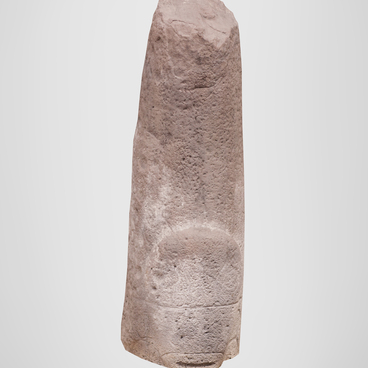The main feature of the Okunev culture of the end of the 3rd millennium BC — the beginning of the 2nd millennium BC is the Okunev masks — high stone stelas on which the faces of ancient deities were carved. Such masks belonged to anthropomorphic —humanoid —images of the Early Bronze Age.
The stone stela, which is on display at the museum, was found during excavations led by archaeologist Andrei Gotlib. They were held in the Shirinsky region of the Republic of Khakassia, on the territory of the ancient burial ground Chernoozernoe-2.
The statue was carved on dark gray dense sandstone. The widest part of the stela is at the top of the stone block and is made in the shape of a triangle. Towards the bottom, the sandstone block narrows and takes on a rectangular shape. In the middle of the front part of the stela, the master depicted the mask of a three-eyed deity.
As a rule, the image of such masks was associated with the cult of the solar deity, which was revered by the Okunev people. The eyes of the deity on the statue are located at the same level; these are circles with a diameter of up to 8 centimeters. Above each circle there are two lines that close up and form a triangle.
There are several versions why three eyes were depicted on the faces of the solar deity, and not two, as on some other stelas. According to one of them, this is due to the belief that the luminary can be angry: when it opens its third eye, a drought sets in on the earth. According to another version, the third eye of the solar deity symbolized his ability to see human vices and know about all human thoughts.
According to the third version, the eyes symbolized the position of the sun in the sky: morning, afternoon and evening. The luminary made a full circle, which was also associated with the life cycle: it rose over the horizon in the east, stood at its zenith at noon, and fell in the west beyond the horizon. Also, three eyes could denote the division into three worlds: Upper, where gods and light forces lived, Middle — with people and spirits associated with them, and Lower — the world of the underworld.
The mask itself is an open oval. Under the horizontal line at the bottom of it, the master depicted the mouth of the deity in the form of a long rectangle. On top of the face there are shallow oval wells. Presumably they were painted later than the main painting.
The stone stela, which is on display at the museum, was found during excavations led by archaeologist Andrei Gotlib. They were held in the Shirinsky region of the Republic of Khakassia, on the territory of the ancient burial ground Chernoozernoe-2.
The statue was carved on dark gray dense sandstone. The widest part of the stela is at the top of the stone block and is made in the shape of a triangle. Towards the bottom, the sandstone block narrows and takes on a rectangular shape. In the middle of the front part of the stela, the master depicted the mask of a three-eyed deity.
As a rule, the image of such masks was associated with the cult of the solar deity, which was revered by the Okunev people. The eyes of the deity on the statue are located at the same level; these are circles with a diameter of up to 8 centimeters. Above each circle there are two lines that close up and form a triangle.
There are several versions why three eyes were depicted on the faces of the solar deity, and not two, as on some other stelas. According to one of them, this is due to the belief that the luminary can be angry: when it opens its third eye, a drought sets in on the earth. According to another version, the third eye of the solar deity symbolized his ability to see human vices and know about all human thoughts.
According to the third version, the eyes symbolized the position of the sun in the sky: morning, afternoon and evening. The luminary made a full circle, which was also associated with the life cycle: it rose over the horizon in the east, stood at its zenith at noon, and fell in the west beyond the horizon. Also, three eyes could denote the division into three worlds: Upper, where gods and light forces lived, Middle — with people and spirits associated with them, and Lower — the world of the underworld.
The mask itself is an open oval. Under the horizontal line at the bottom of it, the master depicted the mouth of the deity in the form of a long rectangle. On top of the face there are shallow oval wells. Presumably they were painted later than the main painting.



